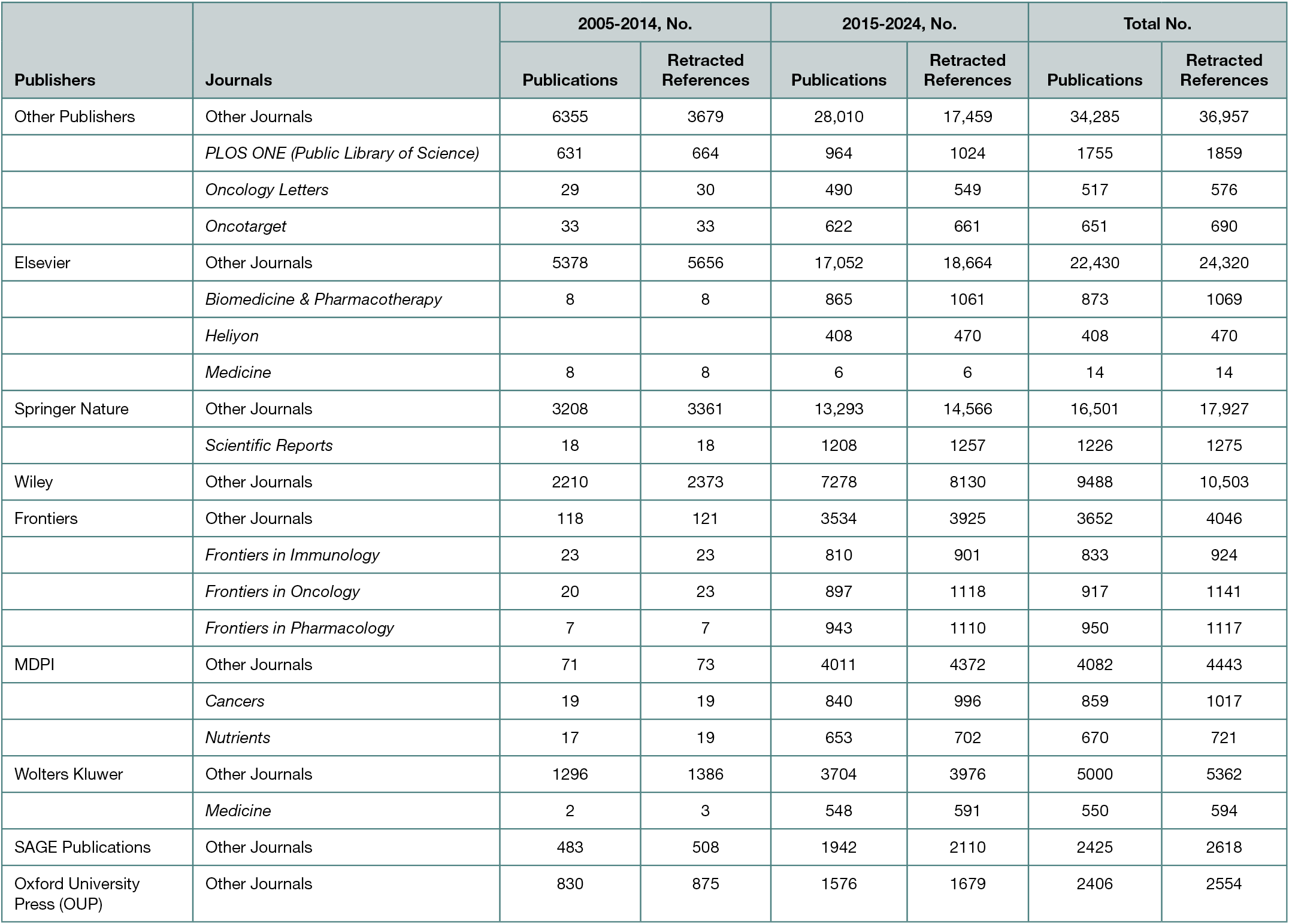Abstract
Postretraction References in Biomedical and Clinical Sciences
Guillaume Cabanac,1,2 Kathryn Weber-Boer3
Objective
We analyzed postretraction citations of retracted publications in biomedical and clinical sciences (BCS). Previous studies have investigated the citation of retracted clinical trials1 and the citation of retracted publications in policy documents,2 but the share of references cited after their retraction in BCS literature is unknown. We identified the articles citing postretracted references and present the results aggregated at the journal and publisher levels.
Design
We used Dimensions data accessed in BigQuery to delineate the corpus, including publications of type ‘article’, classified as “review article” or “research article”, with the field of research category BCS (32, in the ANZSRC 2020 classification), published between 2005 and 2024. We used the snapshot of the Dimensions dataset from 1 June 2025. These 12,240,884 articles were published in 44,901 journals from 11,961 publishers, and contained 401,909,282 references of 28,058,673 unique publications. We extracted the year of publication, journal titles, publisher names, and list of references cited. We retained those references which were removed, retracted, or withdrawn (henceforth ‘retracted’), based on data derived from Crossref, PubMed, Retraction Watch, and retraction notices issued by publishers. We excluded publications which cited retractions which had a retraction year earlier than or equal to the year of publication, to consider only “post-retraction references.”
Results
We observed a growing number of publications in the BSC literature that cite retracted publications. In 2005, there were 674 publications referencing 638 retracted publications 688 times. This grew to 13,927 publications referencing 14,214 retracted publications 15,339 times in 2024: a 2066% increase in publications and retracted references and a 2228% increase in retracted publications cited. This compared to an increase over the same period of 267% for publications in BSC (from 368,338 to 983,837) and 390% in citations (8,495,152 to 33,143,231). This is an increase in the proportion of publications with retracted references from to 0.18% to 1.69% of all BSC publications. The number of retracted publications referenced doubled since 2019. The connection between journal and publisher reflected the ownership relationship as of approximately January 2025. The journals in which post-retraction referencing of retracted literature occurred are many (7225 distinct journals, 17%), but over half of the publications (57,292 of 110,492) are currently owned by four major publishers: Elsevier (23,725; 21%), Springer Nature (17,727; 16%), Wiley (9488; 9%), and Frontiers (6352; 6%).(Table 25-1151)
Conclusions
The publishers of articles responsible for the most citations of postretracted references are the largest publishers of scientific literature by any measure. We could have ranked or displayed the results by publisher or journal as a percentage of publications overall; however, in this case, quantity matters more than share. This practice is preventable, with system-wide corrective efforts by the publishing industry, such as prepublication checks for retracted references, as a complement to the postpublication checks of retracted references that are also needed.3
References
1. Kataoka Y, Banno M, Tsujimoto Y, et al. Retracted randomized controlled trials were cited and not corrected in systematic reviews and clinical practice guidelines. J Clin Epidemiol. 2022;150:90-97. doi:10.1016/j.jclinepi.2022.06.015
2. Malkov D, Yaqub O, Siepel J. The spread of retracted research into policy literature. Quant Sci Stud. 2023;4(1):68-90. doi:10.1162/qss_a_00243
3. Cabanac G. Chain retraction: how to stop bad science propagating through the literature. Nature. 2024;632(8027):977-979. doi:10.1038/d41586-024-02747-1
1Université de Toulouse, IRIT (UMR 5505 CNRS), Toulouse, France; 2Institut Universitaire de France, Paris, France; 3Digital Science, London, UK, k.weberboer@digital-science.com.
Conflict of Interest Disclosures
Kathryn Weber-Boer is employed by Digital Science, which provided access to the Dimensions datasets that this work analyzed. Guillaume Cabanac received funding from the Institut Universitaire de France.
Additional Information
Guillaume Cabanac and Kathryn Weber-Boer are co–corresponding authors.

